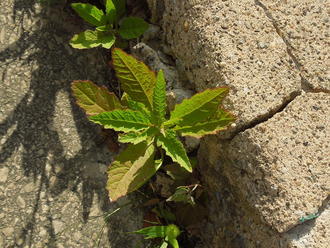Epazote (Dysphania ambrosioides (L.) Mosyakin & Clemants)
Also known as Mexican tea, wormseed, Jesuit's tea; also classified as Chenopodium ambrosioides L.
↑Summary
An annual or short-lived perennial native to central and south America, introduced into North America, where it is now widely distributed.
↑Range - Expand
| Legend | Color |
| Introduced | |
| Introduced or Not Present |
This tentative map is based on our own research. It may have limited data on Canada and/or Mexico, and there is some subjectivity in our assignment of plants as introduced vs. expanded. Read more in this blog post.
Although this plant occurs somewhere in each of these regions, it may only occur in a small part of some or all of them.
↑Uses
Epazote is used as a vegetable, herb, and herbal tea, particularly in Mexican culture. It is commercially cultivated and sometimes sold in Mexican groceries in the U.S. Like most strong-flavored herbs, it is usually only used in small quantities, and has some toxicity if too much is consumed.
↑Links & External Resources
• Dysphania ambrosioides (Mexican Tea) | USDA PLANTS Database (About This Site)
• Dysphania ambrosioides | Go Botany (About This Site)
• Mexican Tea | iNaturalist (About This Site)
• Dysphania ambrosioides | Biota of North America Project (BONAP) (About This Site)
• Dysphania ambrosioides | Flora of North America (About This Site)
• Chenopodium ambrosioides (Mexican Tea) | Illinois Wildflowers (About This Site)
• Chenopodium ambrosioides | Missouri Plants (About This Site)
• Mexican Tea | Maryland Biodiversity Project (About This Site)
• Dysphania ambrosioides (L.) Mosyakin & Clemants (Mexican Tea, Wormseed, Epazote) | Digital Atlas of the Virginia Flora (About This Site)



